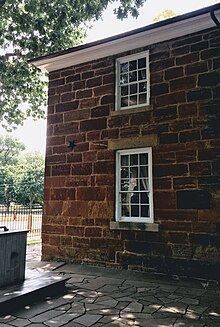
John Taylor was an English-born religious leader who served as the third president of the Church of Jesus Christ of Latter-day Saints from 1880 to 1887. He is the first and so far only president of the LDS Church to have been born outside the United States.

"The Council of Fifty" was a Latter Day Saint organization established by Joseph Smith in 1844 to symbolize and represent a future theocratic or theodemocratic "Kingdom of God" on the earth. Smith prophetically claimed that this Kingdom would be established in preparation for the Millennium and the Second Coming of Jesus.

The Latter Day Saint movement is a religious movement within Christianity that arose during the Second Great Awakening in the early 19th century and that led to the set of doctrines, practices, and cultures called Mormonism, and to the existence of numerous Latter Day Saint churches. Its history is characterized by intense controversy and persecution in reaction to some of the movement's doctrines and practices and their relationship to mainstream Christianity. The purpose of this article is to give an overview of the different groups, beliefs, and denominations that began with the influence of Joseph Smith.
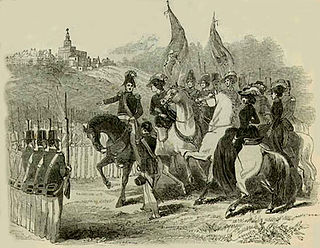
The Nauvoo Legion was a state-authorized militia of the city of Nauvoo, Illinois, United States. With growing antagonism from surrounding settlements it came to have as its main function the defense of Nauvoo, and surrounding Latter Day Saint areas of settlement.

Hyrum Smith was an American religious leader in the Church of Jesus Christ of Latter Day Saints, the original church of the Latter Day Saint movement. He was the older brother of the movement's founder, Joseph Smith, and was killed with his brother at Carthage Jail where they were being held awaiting trial.
Joseph Smith: The Prophet of the Restoration is a 2005 film that focuses on some of the events during the life of Joseph Smith, founder of the Latter Day Saint movement, which was both filmed and distributed by the Church of Jesus Christ of Latter-day Saints. The film was shown in the Legacy Theater of the Joseph Smith Memorial Building from its opening on December 17, 2005 until early 2015, and opened in several LDS Church visitors' centers on December 24, 2005.
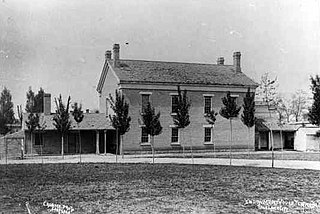
The Endowment House was an early building used by the Church of Jesus Christ of Latter-day Saints to administer temple ordinances in Salt Lake City, Utah Territory. From the construction of the Council House in 1852, Salt Lake City's first public building, until the construction of the Endowment House, the members of the LDS Church used the top floor of the Council House for administering temple ordinances. When this arrangement proved impractical, Brigham Young directed Truman O. Angell, architect of the Salt Lake Temple, to design a temporary temple. Completed in 1855, the building was dedicated by Heber C. Kimball and came to be called the Endowment House after the endowment ceremonies that were conducted inside it.
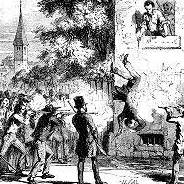
Joseph Smith, the founder and leader of the Latter Day Saint movement, and his brother, Hyrum Smith, were killed by a mob in Carthage, Illinois, United States, on June 27, 1844, while awaiting trial in the town jail.
Bible Dictionary is an official publication of the Church of Jesus Christ of Latter-day Saints. Since 1979, Bible Dictionary has been published as an appendix to most copies of the King James Version (KJV) of the Bible printed by the LDS Church. The dictionary contains 1285 entries on 196 pages. The publication states that it was "designed to provide teachers and students with a concise collection of definitions and explanations of items that are mentioned in or are otherwise associated with the Bible."
John Portineus Greene was an early leader in the Latter Day Saint movement.

The Church History Museum, formerly the Museum of Church History and Art, is the premier museum operated by the Church History Department of the Church of Jesus Christ of Latter-day Saints. It is located in Salt Lake City, Utah, and is opposite the west gates of the church's Temple Square.
Dennis Von Smith is an American sculptor. He is a Latter-day Saint and some of his artwork deals with LDS themes.

The Joseph Smith Mansion House in Nauvoo, Illinois is a building constructed by Joseph Smith, the founder of the Latter Day Saint movement. Smith used the house as a personal home, a public boarding house, a hotel, and as a site for the performance of temple ordinances.
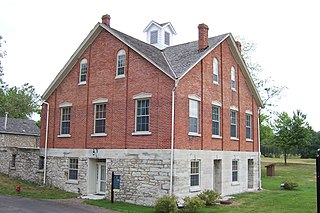
The Nauvoo House in Nauvoo, Illinois, is a boarding house that Joseph Smith, the founder of the Latter Day Saint movement, began constructing in the 1840s. The boarding house was never completed, but the structure was later converted into a residential home and renamed the Riverside Mansion. The Nauvoo House, as it is referred to today, is part of the Nauvoo Historic District, a National Historic Landmark.
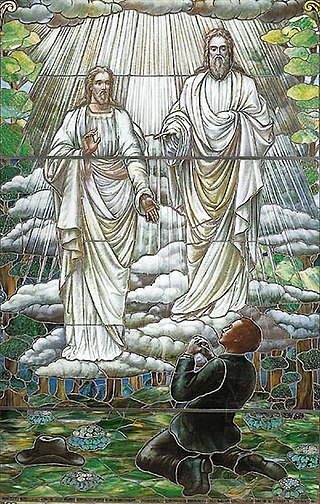
Mormon art comprises all visual art created to depict the principles and teachings of the Church of Jesus Christ of Latter-day Saints, as well as art deriving from the inspiration of an artist's LDS religious views. Mormon art includes painting, sculpture, quilt work, photography, graphic art, and other mediums, and shares common attributes reflecting Latter-day Saint teachings and values.

The Church of Jesus Christ of Latter-day Saints in Illinois refers to the Church of Jesus Christ of Latter-day Saints and its members in Illinois. The official church membership as a percentage of general population was 0.44% in 2014. According to the 2014 Pew Forum on Religion & Public Life survey, less than 1% of Illinoisans self-identify themselves most closely with The Church of Jesus Christ of Latter-day Saints. The LDS Church is the 13th largest denomination in Illinois.

The following outline is provided as an overview of and topical guide to the life and influence of Joseph Smith:

